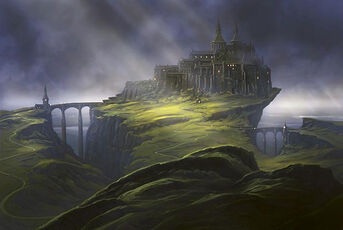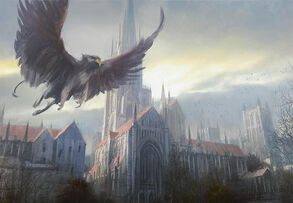
The province of Gavony is where humanity remains safest and strongest. It is home to Thraben, the plane's largest city. Thraben houses the Cathedral of Avacyn, where the archangel herself resided before vanishing. Smaller towns radiate outward from Thraben across Gavony's rocky moors. Small copses of trees dot the landscape of rolling hills and heaths. Because more human dead are buried here than anywhere else, Gavony is more plagued by the undead than other provinces, and geists are more common as well.
Thraben, the High City[]

The city of Thraben sits on a massive mesa in the middle of the Lake of Herons, a long body of water that flows around the rock and over an enormous waterfall. The eastern tip of the rock juts out over the waterfall itself, and it is on this dramatic pinnacle that the Cathedral of Avacyn stands.
Thraben is the largest city in the known lands of Innistrad. It's the seat of the Avacynian Church, built as a city of walls and various bulwarks designed to keep supernatural threats at bay. While smaller settlements are constantly under siege by monsters, the inner parts of Thraben and the Cathedral are the safest areas in Innistrad, which sometimes gives the bishops of the church a skewed perspective on how dangerous the world outside really is.
The Walls of Thraben are a complex system of bulwarks and defense lines. There are remnants of older walls, which have crumbled and lost their effectiveness. But even the old walls demarcate the city into sections, some which have a penal or ceremonial function.
- Outer Wall. The main defense of Thraben. A thick, high wall that rings the perimeter of the city. The church has approved the expansion of the wall several times to keep the city from getting too crowded.
- Merchant's Wall. A complex of fellowship halls that forms a substantial market square. This is the center of commerce in Thraben.
- Child's Wall. The inner wall that surrounds the grounds of the Old Cathedral. Nearly as strong and tall as the outer wall, the Child's Wall has not been altered in ages. It is inscribed with the names of every child born in Innistrad. Many parents make a pilgrimage to the wall in the year after their child's birth, believing that having their child's name written on the wall will add protection to its life.
- Fang Wall. When werewolves are caught, they are executed in front of this wall. Then their fangs are removed and shoved between the crevices of the stones.
- Bloodless Wall. When vampires are caught, they are chained to this wall and left to starve to death.
Cathedral of Avacyn[]

A massive cathedral with three wings and a network of cloisters, courtyards, outlying schools, and forges. There are well-kept gardens and substantial training grounds for cathars (holy warriors). Outside of Thraben, churches are quite rustic, constructed from rough planks and often containing only a single room. The Cathedral is opulent by comparison.
The grounds between the wings form a triangular courtyard that is locked from public view by high walls. Most people don't know the courtyard exists. Only the most powerful bishops are permitted to set foot in it.
The Cathedral's structure symbolically divides the wealthy and poor of the world. Each class has its own designated place to worship:
- Chapel of Noble Peers. The opulent, gilded chapel that is reserved for the high levels of clergy and titled members of society.
- Midvast Hall. The larger, less opulent hall for ordained fellows and lesser clergy.
- Common Cloisters. The covered corridors along the edges Midvast Hall where commoners stand during worship. There are only certain holy days when the commoners are permitted to enter the Old Cathedral.

At first glance, the courtyard resembles an ornate garden with stands of fruit trees and gold-and-white flowers that are cultivated with painstaking care. At the heart of the garden, the trees fall away, leaving a view of a curious object: the Helvault.
The Helvault[]
The Helvault is a huge silver mass that stands at the precipice inside the courtyard of the Cathedral of Avacyn. Its surface is rough and unrefined, and thin veins of dark mortar branch across its surface
The River Kirch[]

This wide, fast-flowing river originates in the mountains of Stensia. It empties into the Lake of Herons, with murky water, high ridges bordering the bank, and depths of hundreds of feet. Great sea serpents and other creatures are said to hide in the depths of the Lake of Herons, which stretches almost 20 miles before flowing over the 2,000-foot waterfall known as Kirch Falls.
The Voice of the Moon[]
On Innistrad, as elsewhere, the moon controls the tides (as well as the path of rivers and other bodies of water). The River Kirch flows into the Lake of Herons, over Kirch Falls, and into the sea. The continuous roar of the water over the falls has a different rhythm depending on the season and volume of water coming down from the high lands. The Cathedral grounds are lush and fertile from the continual spray of mist.

Moonchanters[]
A sect of clergy sing prayers according to this changing rhythm, believing it puts them in better connection with the moon. Others in the church believe that you should commune with Avacyn herself, not the symbolic power of the moon.
Seraphic Shrouds[]
The mist from the waterfall is collected in long banners of heavy, white cloth. The water wrung out is considered holy, but once it is gone, the shrouds still have magical properties. Skaberen will kill for these shrouds, as they give extra stamina to their undead skaab creations.
Gavony's Geography[]

Thraben lies in on the northern edge of the province of Gavony. It's the largest walled city in Innistrad, although parts of Nephalia's seaports are more densely populated. Thraben's population is mainly clergy, merchants, and artisans. With the church's influence, the city maintains a high standard of cleanliness and order. There is a standing militia and the church pays a host of workers to keep the streets swept, the public gardens and grafs tended, and the riff-raff off the street. Begging is strictly prohibited, and there is a street curfew enforced by the militia. Several alms houses exist just outside the main walls of Thraben, and the church regularly sponsors "caravans" to take the needy to the sea ports, where they will ostensibly be able to find employment or trade work more easily.
Gavony Parishes[]
Parishes are an administrative designation used by the church. Gavony has five parishes, including Thraben. There are three in the area called Nearheath: Videns, Wittal, and Effalen. The region known as the Moorland is a single parish of the same name, although it is larger in size than the other four combined. Each parish may have multiple priests, chapels, and small altars.
Nearheath[]
Within a few miles south of Thraben's walls, there are several medium-sized towns. This area is called the Nearheath and is inhabited mainly by artisans and farmers. Being so close to Thraben affords a good deal of protection to these towns. Most have fortifications or walls in case of a ghoul attack or some other threat, but there are many outlying farms as well. Nearheath is composed of several parishes:
- Videns. A region of vineyards and rolling hills with small castles with walled estates. The River Kirch runs through this region.
- Wittal. This is the most thickly forested area of Gavony. Although small in size, the forest is dense and dark, with ancient pines trees that dwarf the deciduous forests in the neighboring parishes. The forest has become particularly dangerous now that the infamous werewolf Skaharra and her Leeraug cohorts have moved to the area.
- Effalen. This is the rockiest area of Gavony. A vicious coterie of vampires have taken to preying on the periphery of the parish for sport.

Two of the main villages in the Nearheath are Estwald and Hanweir. Estwald is the center of woodworking in Gavony and part of the Wittal Parish. Hanweir is the agricultural jewel of Gavony. Hanweir is the site of the largest open-air market, the place where livestock are traded and trappers from Kessig bring their wares. Hanweir is in Videns Parish, and the River Kirch runs through the village, making it a bustling port where goods are brought in from the other provinces before being transported up to Thraben by horse and cart.
The Moorland[]
Beyond the Nearheath is the Moorland. This has always been a more desolate region, filled with stories of spectral wolves and wandering spirits. There are few trees in the Moorland and the ground is covered with coarse grass, bracken, and violet heather. There are boulders and standing rocks, and the countryside seems to be covered in perpetual mist. The area is rife with geists, many of them dangerous, and travelers are constantly at risk from them as well as other things that wander the countryside.
Gisa and Geralf[]
There used to be more towns in the Moorland than there are now. Two rival necromancers—brother and sister, both quite insane—moved into the area in recent years. The siblings were scions of a noble family and distant relatives of the current Lunarch. They were banished from Thraben in a hushed scandal and have since moved to the Moorland, where they wage war against one another by raising armies of undead. Their battles have prompted many of the Moorland's inhabitants to move to the Nearheath, leaving the area even more desolate than before. Now, marauding ghouls range freely through the moors, lost playthings in the mad, epic battles of Gisa and Geralf.

Trostad[]
This was formerly a village of trappers on the border with Kessig, which has been entirely overrun by Geralf and his undead creations. His sister constantly lays siege to the village, seemingly for no purpose other than to best her brother. Geralf has grander ambitions and has been sending armies of undead into the Nearheath and raiding villages there.
Grafs[]

There are more graveyards—known as grafs—in Gavony than anywhere else in Innistrad. Thraben in particular has many mausoleums, graveyards, and even paupers' gravesites, because people bring their dead from all over Innistrad to bury them in the perceived safety of the holy city. There is a gate, the Arch of the Dead, through which pilgrims bring the bodies of their loved ones into the city.
Blessed Grafs[]
Thraben has city blocks devoted to burial sites known as Blessed Grafs. These are a grid of tombs and mausoleums under heavy guard from Elgaud soldiers and tended by horticulturists to keep trees and flowers blooming around the tombs. In Thraben, these are the equivalent of parks, and people visit them recreationally. It is considered relaxing to spend time in a place where kin are enjoying their Blessed Sleep.
The Estwald Murders[]
One of the most notorious cases in recent years involved a series of murders in the Wittal Parish. In Innistrad, murder is not unusual, but these deaths were particularly gruesome. The murderer left mauled body parts from the same victim at various chapels and priests' houses. The church sent a renowned inquisitor named Thedis, who was found dead in the same manner, his head mounted on a post near the outer wall of Thraben. Additional inquisitors and a small force of cathars were sent to the area, and it was eventually determined that it was the work of the newly arrived Leeraug werewolf pack, who were making a territorial claim with the grisly leavings. The battalion is still there, having been unable to roust the werewolves from the forest, although they have contained the murders.
